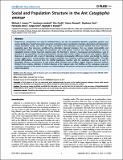Por favor, use este identificador para citar o enlazar a este item:
http://hdl.handle.net/10261/82600COMPARTIR / EXPORTAR:
 SHARE SHARE
 CORE
BASE CORE
BASE
|
|
| Visualizar otros formatos: MARC | Dublin Core | RDF | ORE | MODS | METS | DIDL | DATACITE | |

| Título: | Social and Population Structure in the Ant Cataglyphis emmae |
Autor: | Jowers, Michael J.; Lenniaud, Laurianne; Cerdá, Xim CSIC ORCID ; Alasaad, Samer CSIC ORCID; Caut, Stéphane CSIC; Amor, Fernando; Aron, Serge; Boulay, Raphaël | Fecha de publicación: | 2013 | Editor: | Public Library of Science | Citación: | PLoS ONE, 8(9): e72941 (2013) | Resumen: | Dispersal has consequences not only for individual fitness, but also for population dynamics, population genetics and species distribution. Social Hymenoptera show two contrasting colony reproductive strategies, dependent and independent colony foundation modes, and these are often associated to the population structures derived from inter and intra- population gene flow processes conditioned by alternative dispersal strategies. Here we employ microsatellite and mitochondrial markers to investigate the population and social genetic structure and dispersal patterns in the ant Cataglyphis emmae at both, local and regional scales. We find that C. emmae is monogynous and polyandrous. Lack of detection of any population viscosity and population structure with nuclear markers at the local scale suggests efficient dispersal, in agreement with a lack of inbreeding. Contrasting demographic differences before and during the mating seasons suggest that C. emmae workers raise sexuals in peripheric nest chambers to reduce intracolonial conflicts. The high genetic differentiation recovered from the mtDNA haplotypes, together with the significant correlation of such to geographic distance, and presence of new nuclear alleles between areas (valleys) suggest long-term historical isolation between these regions, indicative of limited dispersal at the regional scale. Our findings on the ecological, social and population structure of this species increases our understanding of the patterns and processes involved under independent colony foundation. | Versión del editor: | http://dx.doi.org/10.1371/journal.pone.0072941 | URI: | http://hdl.handle.net/10261/82600 | DOI: | 10.1371/journal.pone.0072941 |
| Aparece en las colecciones: | (EBD) Artículos |
Ficheros en este ítem:
| Fichero | Descripción | Tamaño | Formato | |
|---|---|---|---|---|
| journal.pone.0072941.pdf | 514,46 kB | Adobe PDF |  Visualizar/Abrir |
CORE Recommender
PubMed Central
Citations
3
checked on 22-mar-2024
SCOPUSTM
Citations
19
checked on 17-abr-2024
WEB OF SCIENCETM
Citations
17
checked on 24-feb-2024
Page view(s)
316
checked on 23-abr-2024
Download(s)
233
checked on 23-abr-2024
Google ScholarTM
Check
Altmetric
Altmetric
Artículos relacionados:
NOTA: Los ítems de Digital.CSIC están protegidos por copyright, con todos los derechos reservados, a menos que se indique lo contrario.
